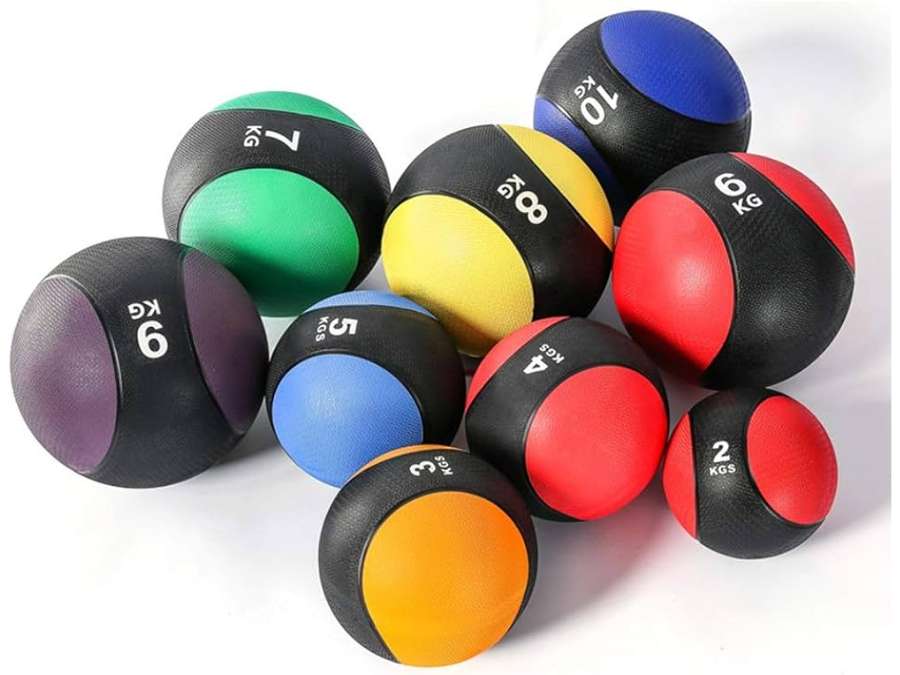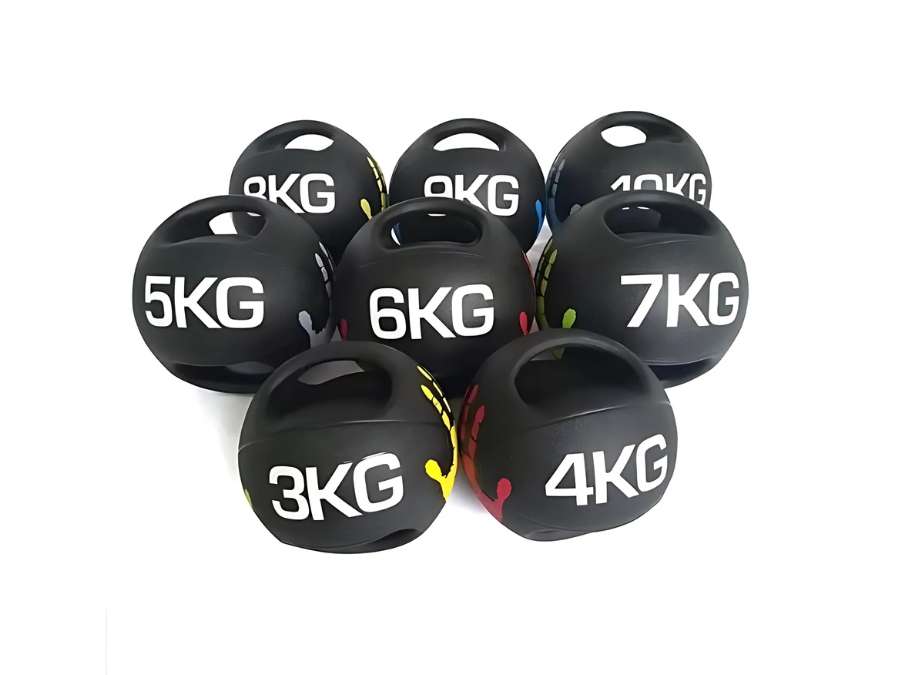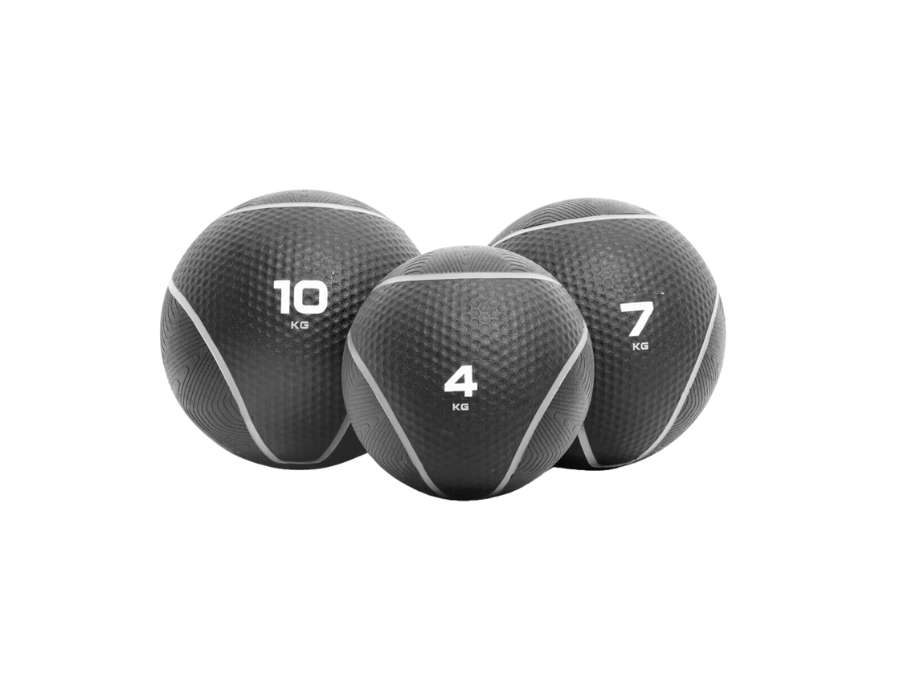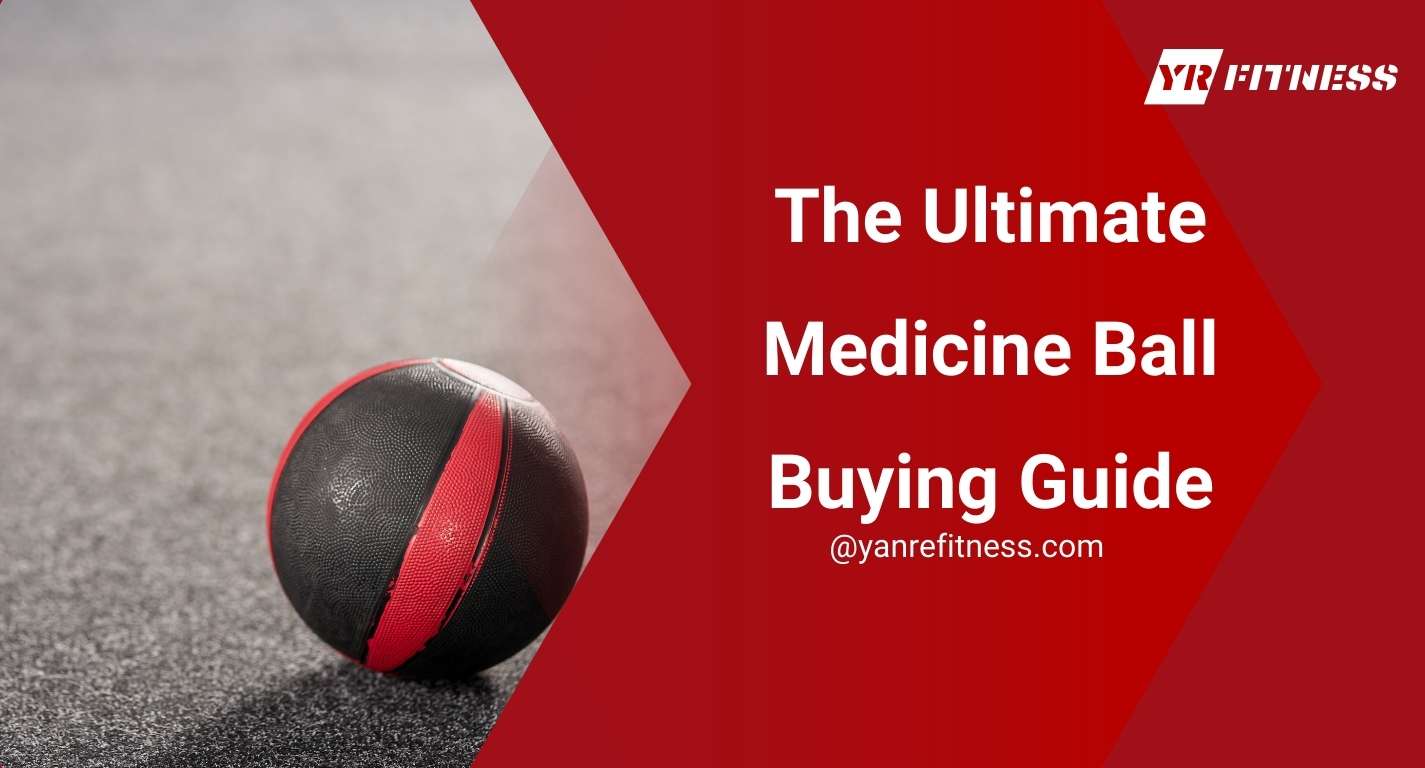Looking to choose the right equipment that keeps your clients engaged? Medicine balls are a timeless fitness tool that adds variety and challenge to workouts.
As a fitness expert with years of experience, I’ve seen how selecting the right equipment can boost a gym’s success. I’m here to share the insights you need to make smart choices for your gym.
Medicine balls remain a key piece of equipment in gyms everywhere. They have long been used for strength training, core stability, and dynamic exercises.
In this guide, we’ll cover the different types, key features, and what to avoid when purchasing.
Let’s get started!
Table of Contents
1. The Difference Between a Medicine Ball, Slam Ball, and Wall Ball
There are a few types of weighted balls used in training, including medicine balls, slam balls, and wall balls. While they come in various sizes (ranging from about the size of a softball to a bit larger than a basketball) and weights (2 lbs to 50 lbs), each type serves a different purpose in workouts. Here’s a quick breakdown to help you choose the right one:
Medicine Ball | Slam Ball | Wall Ball | |
Bounce Level | High bounce, not recommended for wall or floor throws due to rebound risk. | Little to no bounce, designed for slamming without rebounding. | No bounce, specifically designed for wall exercises. |
Durability | May split upon hard impact on the floor. | Durable hard rubber shell, withstands repeated high-impact slams. | Sturdy with padded outer layer and rigid core. |
Material | Typically hollow, lighter weight. | Hard rubber shell with sand or steel shot filling for added weight. | Soft vinyl fabric outer with a firmer internal core. |
Size | Smaller and more compact. | Smaller to medium size. | Generally the largest of the three types. |
Intended Use | For general strength exercises, not ideal for slamming. | Designed for overhead slams onto solid surfaces. | Primarily for wall throws and functional training. |
Weight Range | 2-12 kg (commonly) | 4-18 kg (varies) | 3-12 kg (commonly) |
Special Features | Bounce can be an issue for some exercises. | Sand/steel filling provides minimal bounce and allows proper slamming. | Larger surface area, making it ideal for wall targets. |
2. Types of Medicine Ball
Medicine balls are versatile tools for fitness training. Over time, brands have introduced different versions to improve convenience and flexibility. Today, medicine balls come in various designs, materials, and shapes, and can be categorized into 3 main types:
Bouncy Medicine Balls
Bouncy medicine balls are made with a hard outer shell and filled with air, allowing them to bounce back when thrown. They’re ideal for exercises where the ball needs to return quickly.
Key Features:
- Bounce Factor: Perfect for dynamic workouts but risky for wall or floor throws due to potential rebound injuries.
- Weight: Lighter versions are safer to handle, reducing the chance of accidents during the bounce.
Pros:
- Provides a quick rebound for fast-paced routines.
- Great for improving speed and coordination.
Cons:
- It may be difficult to grip, often requiring both hands.
- Not ideal for heavy slams or hard throws.

Medicine Balls with Handles
Medicine balls with handles are designed for exercises that need a stronger grip, making them easier to use than regular medicine balls. They offer the benefits of both medicine balls and kettlebells.
Key Features:
- Grip: Handles on one or both sides make it easy to hold and control during various movements.
- Material: Typically made from tough polyurethane, they can withstand intense workouts.
Pros:
- Secure grip, perfect for one-handed exercises.
- Great for movements similar to kettlebell exercises.
Cons:
- Pricier than regular medicine balls.
- Not ideal for throwing workouts.

Medicine Balls with Ropes
Medicine balls with ropes, also called tornado balls, are built for powerful swinging exercises. The rope threaded through the ball makes them great for core workouts and high-intensity training.
Key Features:
- Rope Attachment: Some come with a permanent rope, while others offer a removable option for more exercise variety.
- Use: Ideal for swinging and rotational power movements.
Pros:
- Excellent for building core strength and endurance.
- Allows for strong, dynamic movements.
Cons:
- Less common in most gyms, usually seen in specialized training setups.
- Not designed for traditional throwing or slamming exercises.

3. Medicine Ball Physical Structure
A medicine ball is made up of two main parts: its shell and filling. Different materials are used for both, which affect the ball’s durability, grip, and overall performance. Here’s a breakdown of the most common materials used in medicine ball construction:
Shell
Medicine ball shells can be made from a variety of materials, each with its own benefits and drawbacks. Common shell materials include:
Genuine Leather
Leather medicine balls were once the standard and are still popular for their durability and moisture resistance (though too much moisture can damage them).
Key Features:
- Weight Range: Commonly marked with two values (e.g., 10-12 lbs), with slight weight variation.
- Grip: Leather provides a solid grip, ideal for catching and handling during workouts.
- Durability: Leather is tough and long-lasting when properly cared for.
Pros:
- Moisture-resistant (but not fully waterproof)
- Provides an excellent grip
- Durable and long-lasting if well cared for
Cons:
- Weight markings may not be 100% accurate
- More expensive than other types
- Must be kept away from sunlight to avoid damage
- Requires more maintenance than rubber or synthetic balls
- Not as durable as rubber or synthetic materials
Synthetic Leather
Synthetic leather is a popular alternative to genuine leather for medicine balls due to its durability and resistance to impact. Two commonly used types of synthetic leather in these balls are:
PU (Polyurethane)
- Feel: PU looks and feels more like genuine leather, offering a better touch.
- Durability: It has lower wear resistance, with signs of surface damage likely within the first year. Anti-beat ability is under 500 uses.
- Grip: While it provides a good grip, PU can become slippery when hands are sweaty.
Pros:
- Soft, leather-like feel
- Good grip under dry conditions
- Affordable option
Cons:
- Wears out quicker than PVC
- Slippery when wet
- Surface may show damage within a year
PVC (Polyvinyl Chloride)
- Durability: PVC is more resistant to wear and can last 2-3 years, even with regular use. It’s designed to handle impacts like wall throws.
- Moisture Resistance: It’s waterproof, scratch-proof, and moisture-proof, making it ideal for indoor and outdoor use.
- Grades: Comes in 1000D, 500D, and 600D, with 1000D offering the highest durability.
Pros:
- Superior wear resistance, especially in 1000D grade
- Excellent grip, even with moisture
- Tough, handles repeated impacts
- Easy to clean and maintain
Cons:
- Less soft than PU
- Slightly higher cost compared to PU
Rubber
Rubber is a popular material for medicine balls because it can handle heavy impact. While they aren’t made for slamming, people often throw them against walls, which can lead to wear over time.
Key Features:
- Impact Resistance: Rubber is tough and holds up well in throwing and catching exercises.
- Grip: The rubber surface provides a firm grip, so users don’t need to worry about it slipping during workouts.
- Durability: Rubber balls are strong but can crack or deform with heavy use over time.
Pros:
- Strong and durable for high-impact use
- Adds to the ball’s bounce, making it versatile for different exercises
Cons:
- Strong rubber smell
- Latex versions may cause allergic reactions
- More expensive than some other materials
Kevlar
Kevlar is a modern fiber made by Dupont, known for its low weight, high strength, and durability. It’s five times stronger than steel but much lighter, making it perfect for tough medicine balls. It is commonly used in military gear like armored vehicles and bulletproof vests, so it’s no surprise that Kevlar medicine balls are high-quality—but also more expensive. Since Kevlar is patented, it’s important to watch out for fake versions.
Key Features:
- Strength: Five times stronger than steel but only one-fifth the weight.
- Durability: Retains shape after repeated slams and is water-resistant.
- Versatility: Suitable for indoor and outdoor use, and works on surfaces like concrete, pavement, gravel, and asphalt.
- Grip: Textured surface for a firm hold and better control during exercises.
Pros:
- Great for wall slams and tough workouts
- Can be used in any weather, indoors or outdoors
- Strongest and longest-lasting material for medicine balls
Cons:
- The priciest option among medicine balls
Fillings
The filling inside a medicine ball affects its weight, bounce, and how it responds during workouts. Here’s a breakdown of common fillings to help you choose the best option for your needs:
Air
Some medicine balls are filled entirely with air or a mix of air and other materials. These are lightweight, bouncy, and can float. The more air inside, the more the ball will bounce. Air-filled medicine balls need a pump to inflate.
- Best For: Plyometrics and resistance training
- Pros: Lightweight, bouncy, floats
- Cons: Can be dangerous when thrown at walls or the ground
Cotton
Cotton-filled medicine balls are soft and easy to catch, making them ideal for low-impact exercises. They retain their shape well and avoid issues with uneven weight distribution. Some even have double-coated inner sandbags for added balance, durability, and anti-burst properties.
- Best For: Low-impact workouts, catching, and controlled exercises
- Pros: Soft, evenly distributed weight, holds shape well
- Cons: Less suitable for high-impact exercises
Sand
Sand-filled medicine balls are safe for slamming because they don’t bounce back, reducing the risk of injury. However, the weight can shift inside, making the ball feel unbalanced during use.
- Best For: Slamming exercises and workouts where bounce isn’t needed
- Pros: Affordable, safe, doesn’t bounce back
- Cons: Unbalanced weight distribution
Gel
Gel-filled medicine balls are among the cheapest options. They have a vinyl shell with a gel core that prevents bouncing. These are often used in physiotherapy and rehabilitation but are also effective for slamming and long-distance catching and throwing exercises.
- Best For: Rehabilitation, slamming, and long-distance catching/throwing
- Pros: Inexpensive, doesn’t bounce, safe for slamming
- Cons: Less versatile for high-impact, fast-paced exercises
Handle
Medicine balls with handles are commonly made from nylon and come in two styles:
- Straps with plastic grips on the sides
- A single handle on top, similar to a kettlebell
When choosing one, make sure the handles don’t affect the ball’s round shape, as this can make it awkward to use. Weak handles can easily break or bend, making it harder to get a good workout.
Key Features:
- Handle Style: Straps on the sides or a single top handle
- Material: Usually made of durable nylon with plastic grips
- Shape: Handles should not interrupt the ball’s round shape
Pros:
- Provides better grip and control during exercises
- Allows for kettlebell-like movements
- Useful for one-handed workouts
Cons:
- Handles may weaken if poorly constructed
- Can be awkward if the handles disrupt the ball’s roundness
Lace
Some top brands use laces to strengthen a medicine ball at its weak points. These laces help hold the ball together, especially during tough workouts. It’s important that the laces are strong and won’t come undone or wear out quickly.
Key Features:
- Reinforcement: Laces are used to reinforce the ball’s weak points
- Durability: Heavy-duty laces that stay intact during use
Pros:
- Adds extra durability to the ball
- Helps keep the ball intact during intense workouts
Cons:
- Poor-quality laces may unravel or break over time
- Laces can affect the ball’s grip if not properly secured
4. Medicine Ball Physical Properties
As more people focus on health and fitness, medicine balls are becoming more popular. Today, there are many types of medicine balls, each with different features. Below are the key properties to consider when choosing a medicine ball:
Size
A medicine ball’s size doesn’t always match its weight. Most brands stick to a standard diameter of 14 inches for medicine balls, regardless of weight. However, some medicine balls come in different sizes, typically ranging from 8 to 14 inches in diameter. For instance, lighter balls may be smaller, while heavier ones can be larger. Always check for the actual weight printed on the ball.
Weight
A medicine ball’s size doesn’t always match its weight. Always check for the actual weight printed on the ball. Here’s what you need to know:
Weight Range
- Light Balls (2-10 lbs / 1-4.5 kg): Great for cardio, speed training, and core work. They are perfect for fast, repetitive movements and are often used by beginners or in rehabilitation exercises.
- Medium Balls (10-20 lbs / 4.5-9 kg): Best for full-body workouts and strength training. They offer enough resistance for building strength while allowing for dynamic exercises like throws and rotations.
- Heavy Balls (20+ lbs / 9+ kg): These are used for strength-building exercises like squats and slams. They’re ideal for slow, controlled movements and provide maximum resistance for muscle growth.
Factors That Affect Weight
- Material: Heavier balls are made with tougher materials like leather or Kevlar, while lighter ones are often rubber or synthetic. Leather and Kevlar are more durable for heavy-duty exercises.
- Filling: Sand or gel-filled balls are heavier and don’t bounce, making them ideal for slams. Air-filled balls are lighter and bounce more, making them great for fast, dynamic workouts.
- Size and Weight: Some brands keep the ball size the same (usually 14 inches) regardless of weight, while others increase the size with weight. Bigger, heavier balls can be harder to grip and control.
Durability
Medicine balls need to be durable to handle tough, repeated use during workouts. The best medicine balls are designed to resist wear and tear, maintain their shape, and hold up under heavy impact. Below are 2 key factors that determine the durability of a medicine ball:
Stitching
Medicine balls experience heavy use, so reinforced stitching is essential. Double or triple-stitched seams, especially where the material meets, strengthen the ball at its weakest points. Stitches placed inside the ball also prevent unraveling. At YR Fitness, our medicine balls have double-stitched nylon threading for extra durability during rough use.
Shape Retention
Medicine balls can lose their shape after a lot of use. Good-quality balls are made with strong materials that help them keep their shape. These materials stop the inside filling from moving around too much. It’s important for manufacturers to test the balls to make sure they stay firm and don’t change shape over time.
Weight Distribution
The way the weight is spread inside a medicine ball is important for both how long it lasts and how safe it is to use. Below are key things to know about weight distribution:
Importance
- Control: Even weight distribution allows the ball to be handled smoothly during exercises. This balance gives better control, reducing the chance of it slipping or tilting unexpectedly, which helps maintain proper workout form.
- Safety: Uneven weight distribution can cause the ball to behave unpredictably, which is risky during fast movements like slams or throws. A ball with poor balance becomes harder to catch or grip, increasing the potential for accidents or injuries.
Common Issues
- Shifting Weight: In low-quality products, the weight inside the ball may shift, leading to uneven distribution. This can negatively affect the ball’s performance and reliability during workouts.
- Imbalance: When the weight isn’t spread evenly, it creates imbalances that can make the ball harder to control and less effective in training.
Solution
- Testing: Good brands make sure their medicine balls are tested to keep the weight balanced, even after heavy use.
- Reinforcements: To stop the weight from moving around, some brands add extra materials to keep the weight in place. This helps the ball stay balanced and safe over time.
Bounce
Not all medicine balls are designed to bounce. The bounce factor depends on the material and filling, which influences which exercises they are best suited for.
As mentioned earlier, rubber medicine balls offer a good bounce, making them ideal for fast-paced exercises like wall throws. For slams, where bounce is not needed, a slam ball is the better choice since it absorbs impact.
Knowing the bounce factor is important when selecting the right ball for safe and effective workouts.
Traction
The surface texture of a medicine ball plays a key role in handling. Here are some points to consider:
- Slippery Surface: A smooth ball can make it difficult for users to maintain a firm grip, particularly during high-intensity workouts.
- Rough Surface: A textured surface enhances grip but may lead to discomfort or soreness with frequent use.
For users who sweat a lot, traction becomes even more important:
- Using Chalk: Providing chalk can help users keep their hands dry, improving grip and reducing the need to wipe the ball during exercises.
- Without Chalk: If chalk isn’t used, wiping the ball between sets can help maintain a reliable grip during workouts.
Color
Medicine balls are not always color-coded by weight, but some manufacturers use color to distinguish between weight categories. Common color schemes include:
- Lighter Balls (2-6 lbs): Often green or yellow.
- Medium-Weight Balls (8-12 lbs): Typically red or blue.
- Heavier Balls (15+ lbs): Usually black or navy.
However, color coding can vary between brands. To avoid confusion, always confirm the weight by checking the printed number on the ball. The weight, whether in pounds or kilograms, is usually clearly marked on the ball’s surface for easy identification.
Warranty
The warranty of a medicine ball can provide a good indication of its durability. Typically, higher-quality balls come with the following warranties:
- Standard Warranty: At least 1 year, which is common for most good-quality medicine balls.
- Premium Warranty: Up to 2 years for top-tier, durable medicine balls.
A longer warranty generally reflects better durability and build quality, giving buyers confidence in the product’s lifespan.

5. Manufacturing Process
It’s always good to know how medicine balls are made, especially if you want to negotiate better with suppliers. The more you understand the process, the better decisions you can make when it comes to sourcing and pricing. Let’s break it down, using rubber medicine balls as an example:
- Step 1: Cover Material: The process begins by selecting rubber as the outer material. Rubber is chosen for its durability and ability to handle heavy use while providing a good grip during workouts.
- Step 2: Cutting and Sewing: The rubber material is cut into panels that form the ball. These pieces are sewn together using double or triple stitching, providing extra strength to withstand high-impact exercises.
- Step 3: Shape Filling Material: An inner layer, such as foam or additional rubber, is added to help the ball keep its round shape after repeated use.
- Step 4: Weight Filling Material: The ball is filled with materials like sand or gel to give it the right weight. This weight filling defines how the ball is used in different exercises, such as slams or strength training.
- Step 5: Filling by Hand: The weight material is carefully added by hand to guarantee the right amount and even distribution, maintaining the ball’s balance during use.
- Step 6: Sealing: Once filled, the ball is sealed securely to hold the weight material in place. Rubber balls are typically sealed with strong adhesives to prevent leaks or damage.
- Step 7: Logo Treatment: The brand’s logo and the ball’s weight are applied, using embossing, printing, or another method, making it easy to identify the ball’s specifications.
- Step 8: Packaging: After final inspection for quality, the completed rubber medicine balls are packaged and prepared for shipment to distributors and gyms.
6. 4 Tips and Traps to Avoid When Buying Medicine Balls
When buying medicine balls, it’s important to check for features that make them durable, safe, and able to last for a long time. Here are some key tips and things to watch out for:
#1 Durability Testing
When purchasing a medicine ball, ask the manufacturer if it has passed 0s, such as drop or fall tests. A high-quality ball should withstand at least 3,000 drops, indicating its ability to handle long-term, intense use.
#2 Test for Balance
Well-balanced wall balls offer consistent bounce and follow a straight path when thrown. To check balance, roll the ball on the floor for about 3 meters and see if it moves in a straight line.
#3 Embroidered Labels
Choose medicine balls with embroidered weight labels instead of ironed-on or printed ones. Embroidered labels are more durable and won’t peel off or fade, even with regular use.
#4 Size Consistency
When selecting a medicine ball, it’s best to choose brands that keep the same size for all their different weights. This makes it easier for users to switch between weights without changing how they hold or use the ball during exercises.
7. Medicine Ball Quick Comparison Recap
This quick comparison recap highlights the key features of various medicine ball types, helping you easily compare their differences in material, weight, and use. Whether you’re selecting for durability, bounce, or specific workout needs, this table provides a clear overview to guide your choice:
Category | Material/Feature | Grip | Impact Resistance | Durability | Affordability | Odor | Allergens |
Shell | Genuine Leather | Excellent grip, firm | Moderate resistance to heavy impacts, not for slamming | Long-lasting if cared for properly | Expensive | Minimal odor | None |
PU | Good under dry conditions, slippery when wet | Moderate resistance, can wear out quickly | Lower durability, shows damage in 1 year | Affordable | Minimal odor | None | |
PVC | Excellent, even in moisture | High resistance, ideal for wall throws | Can last 2-3 years, depending on grade | Slightly more expensive than PU | Minimal odor | None | |
Rubber | Firm grip | Strong resistance but may wear with time | Strong but may crack or deform | Moderate to expensive | Strong rubber odor | Latex versions may cause allergies | |
Kevlar | Textured surface for firm hold | Extremely high impact resistance | Superior durability, retains shape | Most expensive option | Minimal odor | None | |
Filling | Air | Moderate, depends on cover | High bounce, not suitable for slamming | Lighter, less durable | Affordable | None | None |
Cotton | Soft and easy to grip | Low impact, not for slamming | Retains shape well | Moderate | None | None | |
Sand | Moderate, may shift inside | High impact absorption, no bounce | Can feel unbalanced | Affordable | None | None | |
Gel | Soft and non-slippery | High absorption, no bounce | Moderate durability | Inexpensive | None | None | |
Handle | Nylon/Plastic | Provides good grip and control | Good for one-handed and kettlebell-like movements | May weaken over time | Moderate | None | None |
Lace | Reinforced Laces | Depends on placement | Adds extra durability at weak points | Strong if heavy-duty | Varies based on brand | None | None |
Conclusion
Choosing the right medicine ball can feel overwhelming, especially with so many options and factors to consider. If you’re unsure about which material, weight, or type is best for your needs, YR Fitness is here to help. We offer high-quality, durable medicine balls that are built for long-lasting performance.
In conclusion, this guide is designed to make your decision easier by breaking down everything you need to know about medicine balls. If you have any questions or need help choosing the right product, contact us today!
Related articles:





